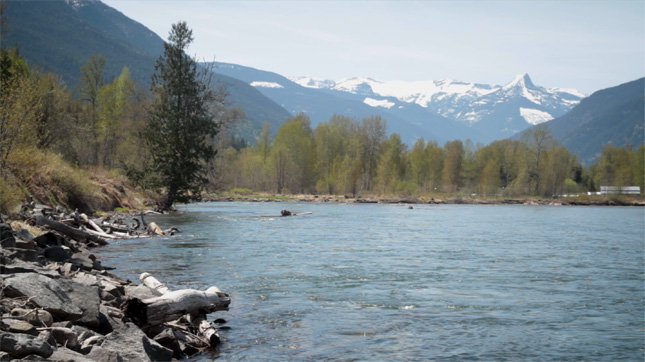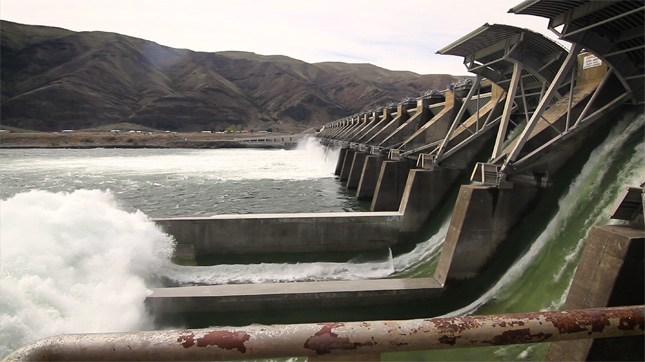-
Water and Governance: Changing Water Laws in a Changing Climate
August 2, 2018 By Elizabeth Herzfeldt-Kamprath
The Columbia River basin—which spans four U.S. states, two Canadian provinces, and 32 Tribal Nations or First Nations—touches the lives of more than five million people each day. The basin’s 250 hydroelectric dams power everything from Google’s data center to irrigation pumps that spread water onto fields of alfalfa and potatoes. Steelhead trout and salmon rely on the river to spawn. Ships and tugboats transport millions of tons of cargo to and from the Pacific Ocean.
But climate change is affecting the river in new, unpredictable ways: Watersheds like the Columbia River basin “are switching from snow- to rain- dominated, [causing] an earlier period of runoff,” said Barbara Cosens, a legal scholar at the University of Idaho’s College of Law at a recent conference in Montana. “Already, it’s measured on average at two weeks earlier than in the past.”
To help navigate the effects of climate change on watersheds, an interdisciplinary team of researchers led by Cosens and Lance Gunderson of Emory University assessed six water basins across the United States as part of a project, “Social-Ecological System Resilience, Climate Change, and Adaptive Water Governance,” funded by the University of Maryland’s National Socio-Environmental Synthesis Center (SESYNC). SESYNC recently interviewed Cosens for a new documentary video, “Water & Governance” (watch below), in its “Research in Action” series. The interview has been lightly edited for length and clarity.
SESYNC: Why is this research vitally important to do now?
Cosens: When the systems we rely on—the water systems, the ecological systems—are facing both an unprecedented rate of change and potentially non-linear change, that itself could be destabilizing. For example, we have allocated water assuming a certain water supply; and all of a sudden, the timing at which that water supply is available and the amount shifts. If we haven’t thought about that in advance and thought about how our laws and systems of governance will handle that change—if we’re caught surprised—that could be destabilizing, and very high levels of conflict could come out of that. People aren’t getting water they need when they need it, and we don’t have a way to manage that.
SESYNC: What were the driving questions that focused your team’s research?
Cosens: One of the major things we wanted to look at was: what is the role of law that provides authority and process, that guides the actions of government in assuring that society is adaptive going forward in managing its resources? We ended up asking research questions in three areas:
One, how does the law play a role in opening a window of opportunity? One thing that social scientists observed is that we don’t, as a society, change what we’re doing except when some disturbance occurs. A disturbance may be a great leader, but it may also be a disaster.
Second, what role does law play in either hindering or helping society adapt? A window opens [and] law can present a barrier to helping you move forward and be adaptive, or law can help facilitate that process. How can we can do the latter rather than the former?
The third was, how do we institutionalize the results of an attempt by society to adapt to changing circumstances? One thing that many have observed is when a window of opportunity opens, people are prepared and psychologically ready to make change. And then it closes, and if you have not found some way to institutionalize the results that come from it, often they’re forgotten, [and] people move on to the next thing. So, law governing government can play a role in making sure the results that come out of a process of dealing with change can be taken up and remain, long term, in the rules we use to manage water resources.

SESYNC: Working across disciplines can be challenging, particularly when you come with different theoretical backgrounds. How did your team work to span those boundaries?
Cosens: Resilience theory helped bring the different disciplines in the room together, because it’s a theory about how complex systems behave. Legal scholars dealing with government, human geographers dealing more broadly with governance, and ecological scholars dealing with ecosystems, are all looking at complex systems, and there are certain behaviors of complex systems that are similar. Resilience theory captured that complexity.
When we think about how a government will respond to managing water in new ways in the face of unprecedented change, it not only has to understand and detect how that system is changing, but the government system itself will have to be adaptive. The concept of adaptive capacity had meaning in each of our disciplines.
Adaptive capacity is very much an aspect of the resilience of a system. We could take that concept and translate it into law, translate it into management actions, and translate it into what’s going on in the ecosystem. It allowed us to think about solutions, think about how law could play a role in bringing those solutions forward.
SESYNC: Your work involved examining six watersheds across the United States to better understand how decision-making through history acted as a trigger, facilitator, or barrier to adaptive governance. Did the watershed assessments also help foster group dynamics?
Cosens: The case studies of the rivers helped us figure out what we meant when we said “resilience,” “governance,” or any of those broad terms. They helped us understand how other members of our team work, think, and write, and they helped us start to have fun because we were working on real problems that basins were facing. If there’s one thing that brought the group together, it was that each of us wanted our work to have more meaning, on the ground.
Elizabeth Herzfeldt-Kamprath is a Multimedia Specialist for SESYNC, which brings together the science of the natural world with the science of human behavior and decision-making to find solutions to complex environmental problems. “Research in Action” is a series of short documentaries that explore the stories of socio-environmental synthesis.
Sources: The Center for Environmental Law & Policy, National Socio-Environmental Synthesis Center (SESYNC), The New York Times
Photo Credits: Photos of the Columbia River, courtesy of SESYNC. All rights reserved.
 A Publication of the Stimson Center.
A Publication of the Stimson Center.




